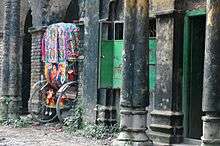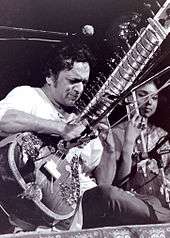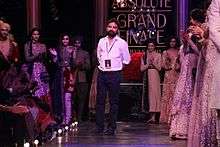Culture of Bengal
| Culture of Bengal |
|---|
_(1438844597).jpg) |
| Mother tongue |
| Regions |
| Faith groups |
| Performing arts |
| Visual arts |
| Martial arts |
| Traditions |
| Other |
The culture of Bengal encompasses the Bengal region in South Asia, including Bangladesh and the Indian states of West Bengal, Tripura and Assam (Barak Valley), where the Bengali language is the official and primary language. Bengal has a recorded history of 4,000 years.[1] The Bengali people are its dominant ethnolinguistic community. The region has been a historical melting pot, blending indigenous traditions with cosmopolitan influences from pan-Indian subcontinental empires. Bengal was the richest part of Medieval India and hosted the subcontinent's most advanced political and cultural centers during the British Raj.[1]
The partition of Bengal left its own cultural legacy. Bangladesh is the scene of a dominant Bengali Muslim culture, whereas Indian Bengali-speaking regions have a Bengali Hindu majority. It must be noted that Muslim-majority Bangladesh is home to a significant Hindu minority, whereas West Bengal has a large Muslim minority. Apart from these, there are also numerous ethnic and religious minorities. Kolkata, the capital of West Bengal, is a cosmopolitan city which houses sizeable number of ethnic communities. Bengal is an important hub of classical South Asian arts. Festivals on the secular Bengali calendar are widely celebrated.
Literature
Bengal has one of the most developed literary traditions in Asia. A descent of ancient Sanskrit and Magadhi Prakrit, the Bengali language evolved circa 1000-1200 CE under the Pala Empire and the Sena dynasty. It became an official court language of the Sultanate of Bengal and absorbed influences from Arabic and Persian. Middle Bengali developed secular literature in the 16th and 17th centuries. It was also spoken in Arakan. The Bengali renaissance in Calcutta developed the modern standardized form of the language in the late 19th and early 20th centuries. Rabindranath Tagore became the first Bengali writer to win the Nobel Prize in Literature in 1913, and was also the first non-European Nobel laureate. Kazi Nazrul Islam became known as the Rebel Poet of British India. After the partition of Bengal, a distinct literary culture developed in East Bengal, which later became East Pakistan and Bangladesh.
Philosophy
The works of ancient philosophers from Bengal have been preserved at libraries in Tibet, China and Central Asia. These include the works of Atisa and Tilopa.[2] Medieval Hindu philosophy featured the works of Chaitanya.
Sufi philosophy was highly influential in Islamic Bengal. Prominent Sufi practitioners were disciples of Jalaluddin Rumi, Abdul-Qadir Gilani and Moinuddin Chishti. One of the most revered Sufi saints of Bengal is Shah Jalal.
Music
.jpg)
Bengal has produced leading figures of Indian classical music, including Alauddin Khan, Ravi Shankar and Ali Akbar Khan. Common musical instruments include the sitar, tabla and sarod. The Baul tradition is a unique regional folk heritage. The most prominent practitioner was Lalon Shah. Other folk music forms include Gombhira, Bhatiali and Bhawaiya. Folk music in Bengal is often accompanied by the ektara, a one-stringed instrument. Other instruments include the dotara, dhol, bamboo flute, and tabla. Songs written by Rabindranath Tagore (Rabindra Sangeet) and Kazi Nazrul Islam (Nazrul geeti) are highly popular. Bangladesh is the center of Bangla rock, as well as indie, Sufi rock and fusion folk music.
Theatre
Bengali theater traces its roots to Sanskrit drama under the Gupta Empire in the 4th century CE. It includes narrative forms, song and dance forms, supra-personae forms, performance with scroll paintings, puppet theatre and the processional forms like the Jatra.
Dance
Bengal has an extremely rich heritage of dancing dating back to antiquity. It includes classical, folk and martial dance traditions.[3][4]
Painting
In antiquity, Bengal was a pioneer of painting in Asia under the Pala Empire. Miniature and scroll painting flourished during the Mughal Empire.
Modern painting emerged in Calcutta with the Bengal school. East Pakistan developed its own contemporary painting tradition under Zainul Abedin. Modern Bangladeshi art has produced many of South Asia's leading painters, including SM Sultan, Mohammad Kibria, Shahabuddin Ahmed, Kanak Chanpa Chakma, Kafil Ahmed, Saifuddin Ahmed, Qayyum Chowdhury, Rashid Choudhury, Quamrul Hassan, Rafiqun Nabi and Syed Jahangir among others.
Architecture
The earliest fortified cities in the region include Wari-Bateshwar, Chandraketugarh and Mahasthangarh. Bengal has a glorious legacy of terracotta architecture from the ancient and medieval periods. The style includes many mosques, temples, palaces, forts, monasteries and caravanserais. Mughal Dhaka was known as the City of Mosques and the Venice of the East. Indo-Saracenic architecture flourished during the British period, particularly among the landed gentry. British Calcutta was known as the City of Palaces. Modernist terracotta architecture in South Asia by architects like Muzharul Islam and Louis Kahn.
Bengali village housing is noted as the origin of the bungalow.
Jewelry
Natural pink pearls are produced by river gypsies in southeastern Bangladesh, with Chittagong as a historic pearl trading center.
The gold industry in Bangladesh is worth US$600 million.[5]
The Dhaka Nawab Family's Daria-i-Noor diamond is the most valuable gemstone in Bengal and is preserved in a vault of Sonali Bank.[6]
Textiles
Muslin production in Bengal dates back to the 4th century BCE. The region exported the fabric to Ancient Greece and Rome.[7]
Bengali silk was known as Ganges Silk in the 13th century Republic of Venice.[8] Mughal Bengal was a major silk exporter. The Bengali silk industry declined after the growth of Japanese silk production. Rajshahi silk continues to be produced in northern Bangladesh. Murshidabad and Malda are the centers of the silk industry in West Bengal.
After the reopening of European trade with medieval India, Mughal Bengal became the world's foremost muslin exporter in the 17th century. Mughal-era Dhaka was a center of the worldwide muslin trade.
The weaving of Jamdani muslin saris in Bangladesh are classified by UNESCO as intangible cultural heritage.
Modern Bangladesh is one of the world's largest textile producers, with a large cotton based ready made garments industry.
Clothing
Bengali women commonly wear the shari (sari), often distinctly designed according to local cultural customs. In urban areas, many women and men wear Western-style attire. Men also wear traditional costumes such as the panjabi with dhuti. As time goes by the lungi, a variant of the sarong, has replaced the dhuti, and now lungi is widely worn by Bangladeshi men.
Bengal has produced several of South Asia's leading fashion designers, including Sabyasachi Mukherjee, Bibi Russell and Rina Latif.
Sculpture
Ancient Bengal was home to the Pala-Sena school of Sculptural Art.[7] Ivory sculptural art flourished across the region under the Nawabs of Bengal. Notable modernist sculptors include Novera Ahmed and Nitun Kundu.
Boats
There are 150 different types of boats and canoes in Bengal. The region was renowned for shipbuilding in the medieval period, when its shipyards catered to major powers in Eurasia, including the Mughals and Ottomans. The types of timber used in boat making are from local woods Jarul (dipterocarpus turbinatus), sal (shorea robusta), sundari (heritiera fomes) and Burma teak (tectons grandis).
Rickshaws

Bangladesh has the world's largest number of cycle rickshaws. Its capital city Dhaka is known as the Rickshaw Capital of the World. The country's rickshaws display colorful rickshaw art, with each city and region have their own distinct style. Rickshaw driving provides employment for nearly a million Bangladeshis.
Historically, Kolkata has been home to the hand-pulled rickshaw. Attempts to ban its use have largely failed.
Cuisine

Bengali cuisine is one of the most extensively developed in Asia. It is notable for its widespread use of freshwater fish and seafood. Bangladeshi cuisine includes greater meat consumption, including beef, duck, chicken, mutton, squab and venison. Indian Bengali cuisine is highly vegetarian, but consumption of chicken, mutton, egg and pork is also common whereas beef is taboo due to the predominance of Hindu culture. The region is also noted for its vast spread of desserts, sweets and confectionery.
Cinema
Kolkata and Dhaka are the centers of Bengali cinema. The region's film industry is notable for history of art films in South Asia, including the works of Academy Award winning director Satyajit Ray and the Cannes Film Festival award winning director Tareque Masud.
Weddings
.jpg)
Bengali weddings includes many rituals and ceremonies that can span several days. Although Muslim and Hindu marriages have their distinctive religious rituals, there are many common secular rituals.[9][10] The Gaye Holud ceremony is held in Bengali weddings of all faiths.
Bengali people not over in Bangladesh only in West Bengal too, Bengali in West Bengal is quite different from other indian Hindu cause of their long cultural history , In Bengali of Calcutta religion culture no matters. For marriage bit love matters , You can find Lots of Bengali Hindu people with wife from different culture different Languages even different country. , Most Bengali Literate person are against dowry. In Bengali now Arranged marriage is almost obsolete, most people support love marriage, and other go for Arrange plus Love marriage where family choose bride and groom and allow them to spend time together for long, if they fall in love each other they move to marriage if No liking or love grow they can move on.
Festivals
Both Bangladesh and Bengal have many festivals and fairs throughout the year.
| Muslim | Hindu | Buddhist | Christian | Secular |
|---|---|---|---|---|
| Eid al-Fitr | Durga Puja | Buddha Purnima | Christmas | Pohela Boishakh (New Year/ Summer) |
| Eid al-Adha | Kali Puja | Madhu Purnima | Easter | Bosonto Utsob (Spring Festival) |
| Muharram | Saraswati Puja | Nabanna (Harvest Festival) | ||
| Milad un Nabi | Dolyatra (Holi) | Poush Sangkranti (Winter Festival) | ||
| Shab-e-Barat | Rath Yatra | Kolkata Book Fair | ||
| Ramadan | Janmashtami | Bhasha Dibas | ||
| Laylat al-Qadr | Jagaddhatri Puja | Kolkata Film Festival | ||
| Bishwa Ijtema | Ganga Sagar Mela | Dhaka Art Summit |
Sports
Cricket and football are popular sports in the Bengal region. Dhaka and Chittagong are home to some of the most renowned football clubs in South Asia and are prominent venues for international cricket. Kolkata is one of the major centers for football in India. Shakib Al Hasan, Mushfiqur Rahim, Mashrafe Bin Mortaza, Tamim Iqbal from Bangladesh and Pankaj Roy, Sourav Ganguly, Manoj Tiwary, Wriddhiman Saha, from West Bengal are internationally known cricketers .[11] Local games include sports such as Kho Kho and Kabaddi, the latter being the national sport of Bangladesh.
Media
Bangladesh's Prothom Alo is the largest circulated Bengali newspaper in the world. It is followed by Ananda Bazar Patrika, which has the largest circulation for a single-edition, regional language newspaper in India. Other prominent Bengali newspapers include the Ittefaq, Jugantor, Samakal, Janakantha and Bartaman. Major English-language newspapers in Bangladesh include the The Daily Star, New Age, Dhaka Tribune, and the weekly Holiday. The Statesman, published from Kolkata, is the region's oldest English-language publication.
See also
Notes
- 1 2 Minahan, James B. (2012). Ethnic Groups of South Asia and the Pacific: An Encyclopedia. ABC-CLIO.
- ↑ Islam, Aminul (2012). "Philosophy". In Islam, Sirajul; Jamal, Ahmed A. Banglapedia: National Encyclopedia of Bangladesh (Second ed.). Asiatic Society of Bangladesh.
- ↑ Hasan, Sheikh Mehedi (2012). "Dance". In Islam, Sirajul; Jamal, Ahmed A. Banglapedia: National Encyclopedia of Bangladesh (Second ed.). Asiatic Society of Bangladesh.
- ↑ Ahmed, Wakil (2012). "Folk Dances". In Islam, Sirajul; Jamal, Ahmed A. Banglapedia: National Encyclopedia of Bangladesh (Second ed.). Asiatic Society of Bangladesh.
- ↑ "Only right policy can help earn $1bn from gold jewellery export".
- ↑ Alamgir, Mohammad (2012). "Daria-i-Noor". In Islam, Sirajul; Jamal, Ahmed A. Banglapedia: National Encyclopedia of Bangladesh (Second ed.). Asiatic Society of Bangladesh.
- 1 2 Snodgrass, Mary Ellen (2015). World Clothing and Fashion: An Encyclopedia of History, Culture, and Social Influence. Routledge.
- ↑ Van Schendel, Willem (2012). "Silk". In Islam, Sirajul; Jamal, Ahmed A. Banglapedia: National Encyclopedia of Bangladesh (Second ed.). Asiatic Society of Bangladesh.
- ↑ "Bengali Wedding Rituals - A Traditional Bengali Marriage Ceremony". about.com. Retrieved 2008-11-21.
- ↑ "Weddings In India - Wedding in Exotic Indian Locations". www.weddingsinindia.com. Retrieved 2008-11-21.
- ↑ Prabhakaran, Shaji (18 January 2003). "Football in India - A Fact File". LongLiveSoccer.com. Archived from the original on 23 October 2006. Retrieved 2006-10-26.



.jpg)
